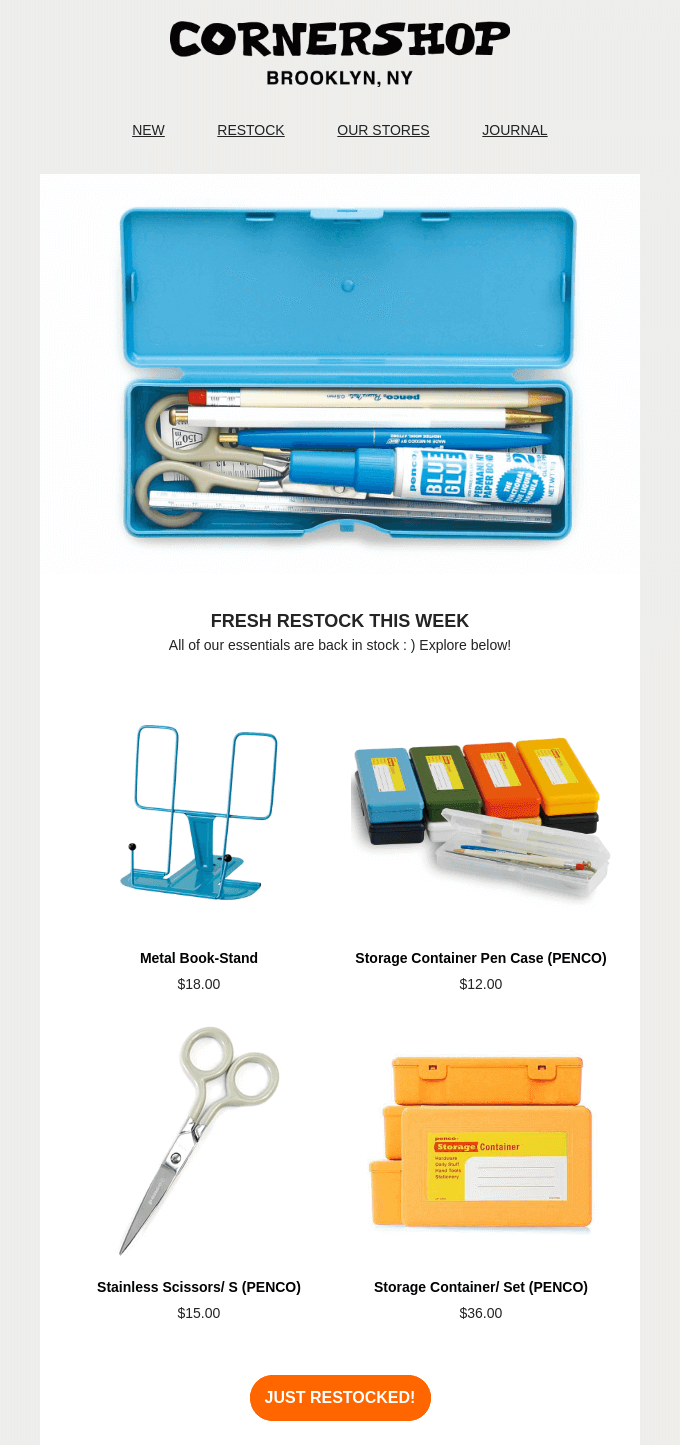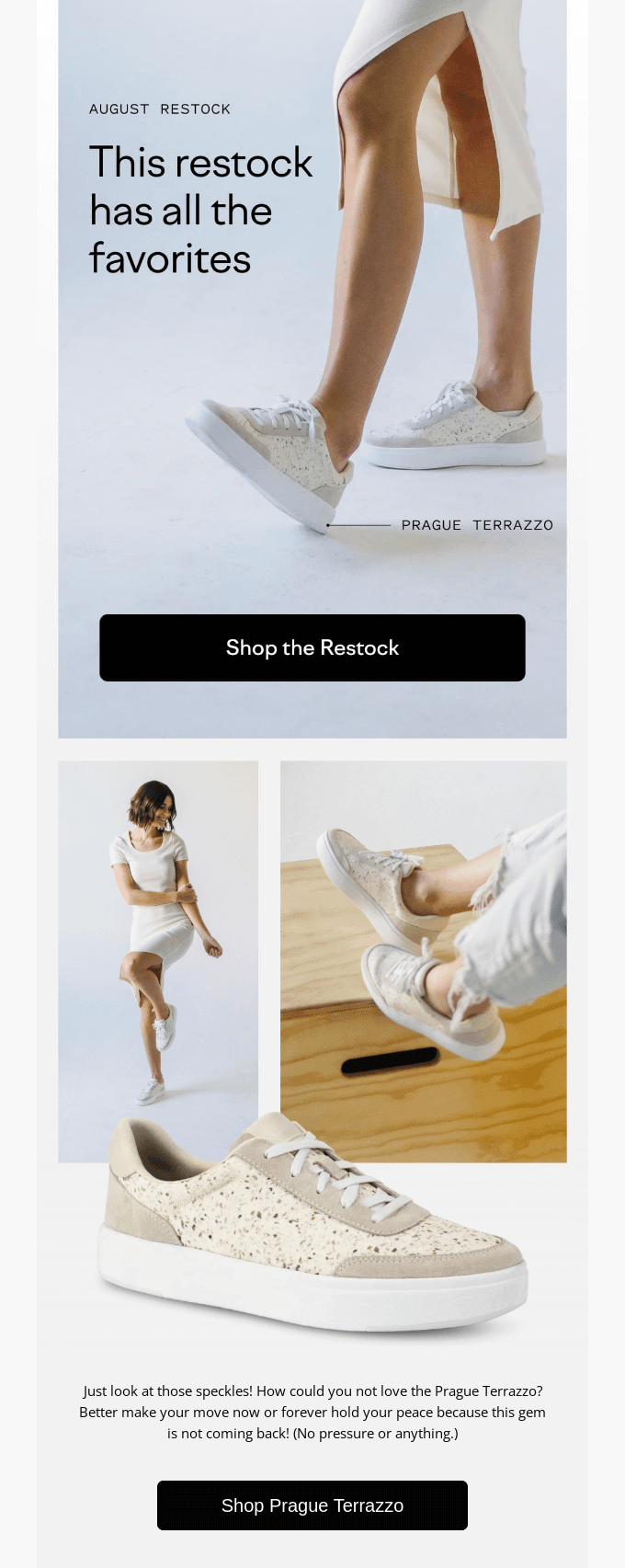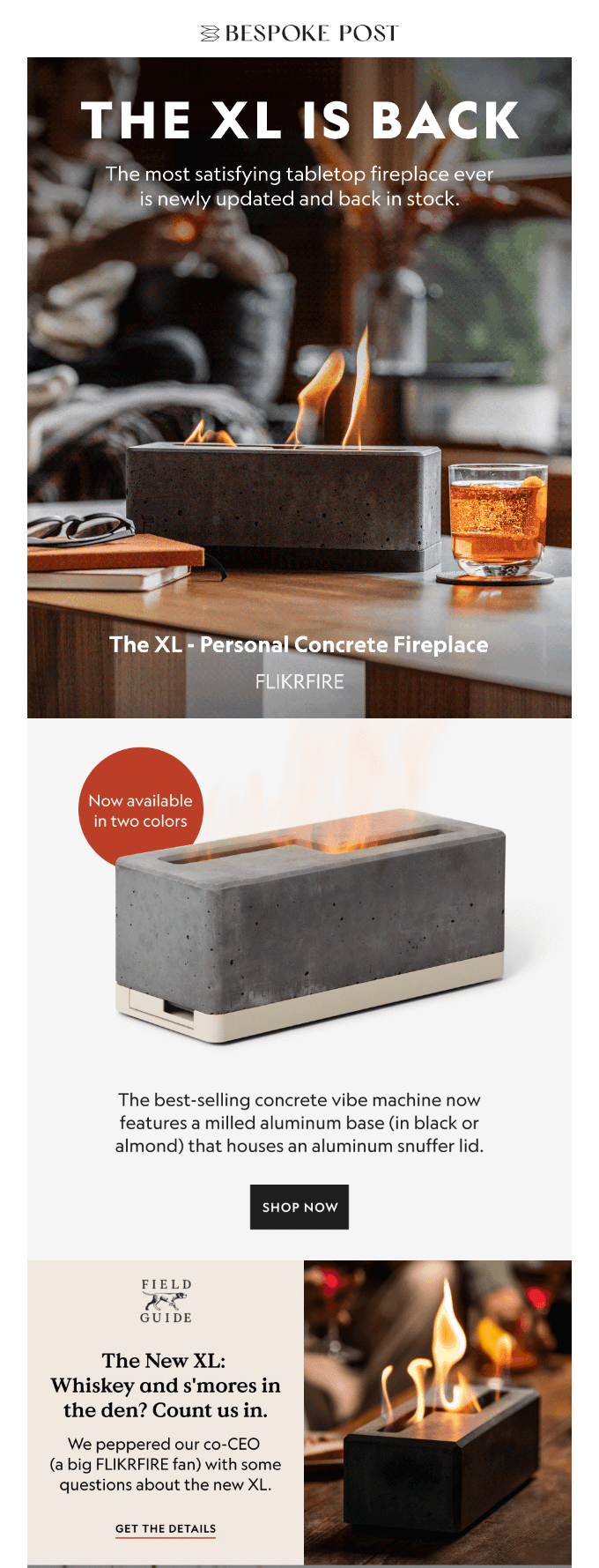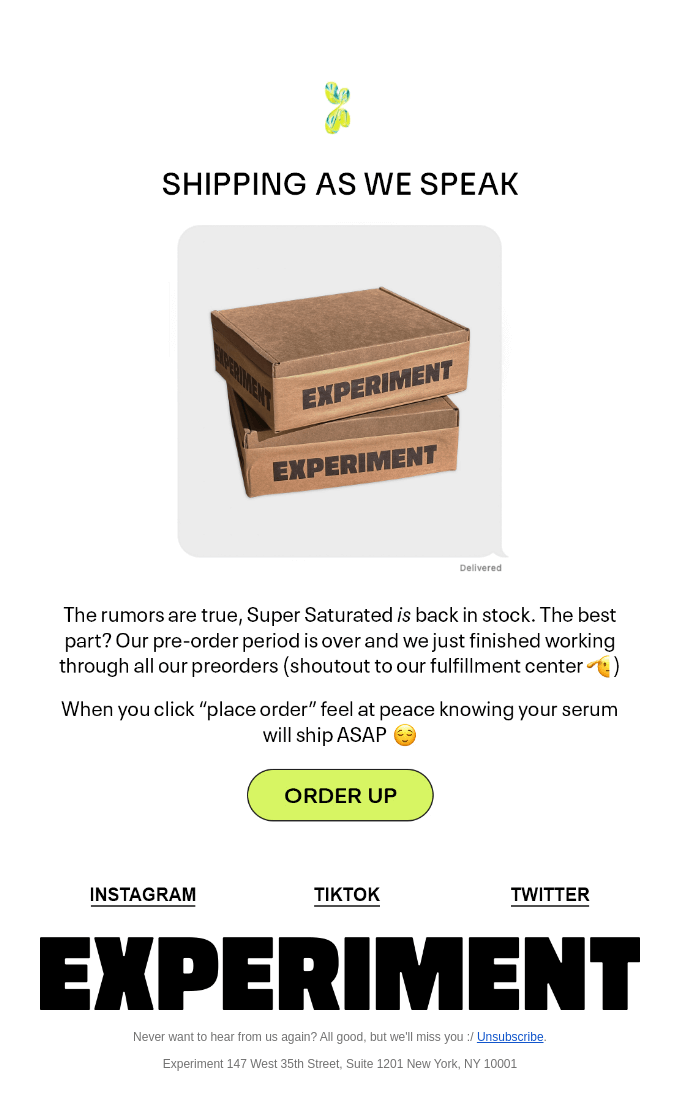If you think the fear of missing out is overrated, just look back at the recent Barbie movie premiere. You’ve probably seen those lines stretching for blocks, the palpable excitement in the air, and the collective anticipation. What made millions of grownups around the world suddenly dress in pink and get so obsessed with some doll?
It’s the power of marketing — specifically, the art of stirring up nostalgia and capitalizing on the collective desire to experience what everyone else covets. It’s how an everyday item turns into a real phenomenon, an absolute must-have product. The best part is that you can unlock the same powerful mechanism that keeps consumers coming back for more with the right type of promotional email.
Let’s learn how a popular product, once sold out and seemingly unattainable, can make a triumphant return. In this blog post, you’ll discover how the skillful use of scarcity, combined with the strategic deployment of back-in-stock emails, creates a dynamic interplay that taps into the consumers’ primal instincts. We’ll equip you with practical tips and real-life examples demonstrating how to awaken an insatiable appetite for more using the right words and visuals.
Content:
- What are back-in-stock emails?
- Why are back-in-stock emails so efficient?
- Back-in-stock email best practices and mistakes to avoid
- Back-in-stock email subject line ideas
- 8 clever back-in-stock email examples to learn from
- How to create a back-in-stock email with SendPulse
- One solution for all of your sales and marketing needs
What are back-in-stock emails?
Let’s imagine you’ve had your eye on that new pair of Nikes that everyone’s buzzing about. You finally decide to treat yourself, only to be met with disappointment — the most popular sizes, including yours, are all sold out. Naturally, you’d leave your email address hoping to receive a sweet “Hey, it’s back in stock!” notification a few weeks later.
That’s precisely what back-in-stock emails are for. They allow customers to seize the opportunity they thought had slipped through their fingers. When that hot-ticket item they’ve been dreaming about returns to the shelves, they immediately learn about it and get the thrill of a second chance.

So, a back-in-stock email is that ping in a customer’s inbox announcing the return of their desired product. It can also notify them that certain sizes or configurations of the product have been restocked. In some cases, back-in-stock emails also announce an epic, long-anticipated comeback of a legendary, old-school product model.
Why are back-in-stock emails so efficient?
The efficiency of back-in-stock emails is indeed tied to the potent psychological force known as FOMO, but there are a few more components at play. Let’s break it down.
Reason #1. Scarcity breeds desire
Back-in-stock emails are a perfect use case for scarcity marketing. When a product is temporarily unavailable or marked as “out of stock,” it automatically becomes more desirable. The scarcity element triggers a psychological response, making individuals perceive the item as more valuable and exclusive.
Reason #2. No one likes to be left behind
FOMO is a powerful motivator. People don’t want to miss out on what everyone else seems to be enjoying. Back-in-stock emails tap into this fear, creating a sense of urgency and prompting spontaneous action. Once the item is back, consumers are less likely to let it vanish again.
Reason #3. It feels good to get a second chance
These emails offer another chance to those who missed out on the initial release. It’s like a retail redemption story. The idea of getting another shot at purchasing a previously sold-out, highly sought-after item adds an emotional component to the shopping experience, making it more rewarding.
Reason #4. You get to craft high-precision offers that are hard to resist
Unlike other promotional campaigns, back-in-stock notifications are all about timing and personalization. They arrive precisely when the product is available again, capitalizing on the customer’s existing interest. This targeted communication ensures the message is relevant and resonates with the individual, increasing the likelihood of conversion.
Reason #5. Your audience sees that you care about their needs
By notifying customers about restocking a popular item, you can show that you are responsive to customer demand. It reinforces a positive connection between your brand and the consumer. It’s not just about making a quick buck — it’s about demonstrating long-term attentiveness to customer preferences.
Reason #6. Boring online shopping suddenly turns into a rollercoaster of emotions
The anticipation built by the initial product launch is usually short-lived, but the “out-of-stock” period can help maintain that buzz around the item. Back-in-stock emails intensify the anticipation, creating excitement around the product — you can expect increased engagement and sales upon restocking.
In essence, back-in-stock emails are far from being purely functional emails. They leverage psychological triggers and turn the seemingly mundane act of restocking into a clever sales move. Hopefully, this has convinced you to incorporate these emails into your strategy. Now, let’s focus on how to do it right.
Back-in-stock email best practices and mistakes to avoid
To make sure your back-in-stock emails fulfill their intended purpose, pay attention to the following details.
- Catch the customer’s interest while it’s fresh. Timing is crucial. Set up automated back-in-stock email notifications to alert customers the second the product becomes available.
- Use customer segmentation. Only target those who have previously shown interest in the restocked item. It ensures your message reaches the most relevant audience.
- Make your emails feel natural and relatable. Addressing the customer by name and referring to their past interactions with the product is a great way to personalize your emails. It will demonstrate to users that your company remembers every one of them.
- Put the restocked product front and center. Showcase the item in the best light by using large, high-quality product photos.
- Let the visuals do the talking. Unless it’s a long-anticipated comeback of a legendary product, your email will benefit from having less text. Fewer wordy descriptions mean fewer distractions.
- Create a sense of urgency. Let your customers know that although the item is back, it’s selling out fast. You can explicitly emphasize limited quantities. Convince them that there isn’t much time left to ponder the purchase.
- Use a clear CTA to encourage your audience to act swiftly. Ensure your call to action is clear, prominently placed, and compelling. Use action-oriented language to prompt immediate clicks.
- Prioritize spontaneous purchases from mobile. Optimize your email for mobile devices since many users may be tempted to place an order directly from their smartphone.
- Provide options for further engagement. Include links to related products or complementary items. It encourages customers to explore more and potentially make additional purchases.
- Prove that the featured product is indeed in high demand. Include raving customer reviews or testimonials related to the restocked item. Social proof can significantly reinforce the product’s desirability.
So far, so good. What can possibly go wrong with back-in-stock emails? Actually, there are a few things you should steer clear of.
- Sending vague, incomplete information. Avoid sending back-in-stock emails that require additional research and browsing. Customers should have all the details they need to make a decision.
- Blasting everyone on your list with identical notifications. Don’t overlook the power of segmentation. Sending the same back-in-stock notification to your entire list may not be as effective as targeting those who have previously shown interest.
- Using generic subject lines. These types of emails are time-sensitive and have higher priority than regular promotional newsletters. Therefore, your back-in-stock email subject lines should reflect that.
- Expect customers to remember the benefits of the restocked product. Wordy emails are not recommended, but using no descriptions at all may also confuse customers. Include a few lines of text to highlight the key features and refresh their memory.
- Neglecting follow-up emails. Don’t forget to send follow-up emails to those who didn’t open the initial back-in-stock notification. A well-timed follow-up can capture additional attention.
By following these best practices and avoiding common mistakes, you can maximize the effectiveness of your back-in-stock email campaigns and enhance customer engagement.
Back-in-stock email subject line ideas
Customers’ attention can be fleeting. That’s why it’s important to craft subject lines that are clear and compelling and convey the urgency of the restock. Make it obvious that the product is back and ready for purchase. Here are some ideas to help you get started:
- Back by Popular Demand: [Product Name] is Here!
- Call Dibs on [Product Name] Because It’s Selling Out Quick
- The Wait Is Over: [Product Name] Back in Stock!
- You Asked, We Listened: [Product Name] is Back
- They Flew Off the Shelves, but We Got More! [Product Name] is Back
- We’ve Just Restocked Your Favorites
- We Know You’ve Been Missing These
- Guess Who’s Back in Town. [Product Name] is Restocked
- Don’t Miss Out: [Product Name] is Back on the Shelves!
- Your Favorites are Back! Shop [Product Name] Now
- We’d Hate For You To Miss This
- The Return of [Product Name]: Snag Yours Before They’re Gone Again
- Back-in-Stock Alert: [Product Name] is Waiting For You
- Hurry! Limited Quantities of [Product Name] Now Available!
- The Legend is Back: We’ve Restocked [Product Name]
- Make Sure You Don’t Sleep on These
- The Comeback You’ve Been Waiting For
- Welcome Back, [Product Name]
- Back-in-Stock Alert: You Can’t Miss These
- This Restock Has Everything You Love
As you can see, some of these back-in-stock email subject lines create intrigue by teasing the return of popular items without revealing them outright. It sparks curiosity and encourages recipients to open the email to discover the exciting news.
You can also highlight that you’ve heard your customers’ requests, creating a sense of responsiveness and customer-centricity. It’s generally a good idea to add emoji for a playful touch. Emoji can convey excitement and visually stand out in crowded inboxes, making your email more appealing.
If your customers use wishlists on your platform, reminding them that their favorite items are now available creates a personalized touch.
Whichever approach you choose, remember to keep your subject lines concise, engaging, and aligned with your brand’s tone. Testing different variations can help you understand what resonates best with your audience.
8 clever back-in-stock email examples to learn from
These back-in-stock emails not only inform but also captivate and convert, serving as inspiration for anyone looking to make a lasting impact on their customers. Let’s get a closer look at them.
Hero Cosmetics
This example deserves first place in our collection as it follows every single back-in-stock email design and copywriting recommendation and executes them beautifully. The headline clearly communicates the key message, and the supporting copy clarifies the rest.

The contrasting CTA button is impossible to miss. In addition, the tight deadline highlights the urgency of the offer, preventing customers from postponing the purchase. The blue “seal of approval” is a nice touch, symbolizing that many others requested this very product. Finally, the use of the primary brand color throughout the email makes it unmistakably recognizable.
Hightide
The following example should give you some more ideas regarding back-in-stock email design. This email from a stationery shop in New York is extremely minimalistic in its design, yet it showcases the restocked products nicely.

The bold CTA button does an excellent job of guiding the user’s attention. The bright, colorful, and crisp product photos seal the deal, showing customers the essentials they didn’t know they needed.
Kizik
If you’re tired of functional, sterile emails and gravitate toward more relaxed, lively designs, this example is for you, as it features natural-looking lifestyle product photos. It’s a brilliant idea for clothing and shoe retailers because it allows brands to instantly communicate what their products look and feel like in real life.

Speaking of generating FOMO, this email masterfully does just that by mentioning the final nature of the offer. We also love how the photos match the overall aesthetic and mood of the brand.
Bespoke Post
Exquisite products require pompous announcements. This example is no exception. The back-in-stock email from a themed subscription box service comes with gorgeous visuals, tasteful descriptions, and intriguing teasers.

Because this is a rather extravagant product, the company doesn’t overwhelm its subscribers with details, redirecting them to a dedicated page instead. This email gets bonus points for the fact that the featured social proof comes from the company’s CEO, who happens to own this very product.
Vacation
Here’s a perfect example of maintaining customer engagement without shiny new arrivals, huge restocks, or epic sales. For instance, this perfume brand decided to surprise its customer base with restocked samples of the main product, which is yet to return to the shelves.

It’s a fantastic way to hype up your customers and give them a taste of what’s about to come. This example also skillfully uses social proof to boost the perceived value of the perfume.
Resy
What if you’re bringing back something really special and want your customers to pay close attention to it? In that case, sending a sequence of back-in-stock emails makes sense, as Resy does here.

It allows you to build up suspense and ensure that no one from your audience will miss the memo. Also, for re-introducing unique and exclusive products, it’s worth it to prepare custom images, like in this example. It will allow you to set the mood and convey the spirit of the product before it hits the shelves.
Fishwife
Back-in-stock emails are often treated as an afterthought, but no one stops you from going the extra mile and using them as an outlet for your creativity. If you are unsure how far you’re allowed to go, draw inspiration from this bubbly example from a seafood company.

This email brings back memories of psychedelic hippie posters from the 80s — it’s that colorful and eye-catching. At the same time, it’s in perfect alignment with the other Fishwife’s brand assets. It’s also worth noting how the brand subtly mentions the crazy demand for these anchovies and gives practical tips on using them in everyday cooking.
Experiment
To rinse the palate, let’s finish up with a more calm and minimalistic example. This hip email boasts Gen-Z-friendly language, appropriate emoji, nice accent colors, and catchy copy. The subject line “In case you live under a rock…” is definitely on the cheeky side, but it speaks to the brand’s target audience, which is all that matters.

The links to Experiment’s social media channels are there for a reason. They help tech-savvy customers do their own research, check out before-afters, and make sure the advertised products work as announced. It also increases transparency as users can read others’ comments and see how the brand responds.
Another thing we love about this email is the customized unsubscribe link at the footer, which makes this email even more personable and charismatic.
How to create a back-in-stock email with SendPulse
You’ll be surprised to learn how easy it is to create a back-in-stock notification campaign if you’re using the right tools. With SendPulse, you can effortlessly customize one of our professionally designed templates, set up automations, and elevate your customer communication game.
Our platform provides a user-friendly drag-and-drop editor, along with other intuitive tools, empowering you to create compelling email campaigns of all kinds in a matter of minutes. Here’s a quick guide on creating a back-in-stock email with SendPulse.
Log in to your SendPulse account or create a new one for free. Navigate to the “Email” tab. Click on “Mailing lists” to import contacts in bulk or add them one by one. Then, go to “My campaigns.” Click “New campaign” and select your mailing list or segment.
Next, browse through our template selection and pick the one that suits your goals. In this case, any visual-first template will work fine.

In the drag-and-drop editor, you can modify the email structure and personalize the design by adding images, text, buttons, and other elements. Make sure to incorporate your brand colors and logo for a cohesive look. Before launching, preview the email to ensure it looks seamless and error-free.
Move on to campaign settings, adjusting the sender name, subject line, and preheader text. Set the sending schedule and delivery time for your back-in-stock campaign. Double-check the campaign settings and make any necessary adjustments. When everything looks good, hit “Send” to kickstart your back-in-stock email campaign.
One solution for all of your sales and marketing needs
In addition to the versatile email builder, SendPulse provides a comprehensive suite of website-building features, CRM capabilities, a user-friendly chatbot builder, an LMS, an SMS marketing platform, and dynamic push notifications.
SendPulse can replace up to 10 conventional marketing and sales tools, offering the same robust capabilities at a fraction of the cost. With our all-in-one platform, you can track your sales, monetize your expertise, and get a holistic view of your marketing activities without breaking the bank. Create your free account now to test it out!









